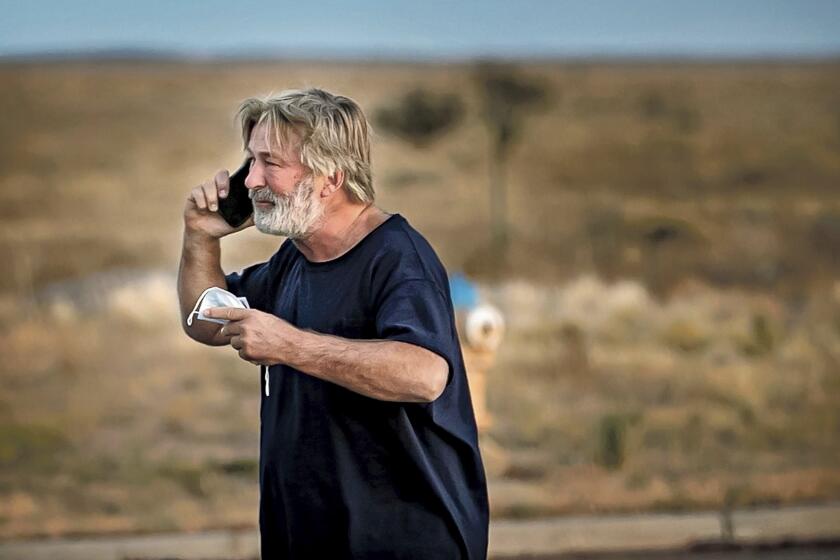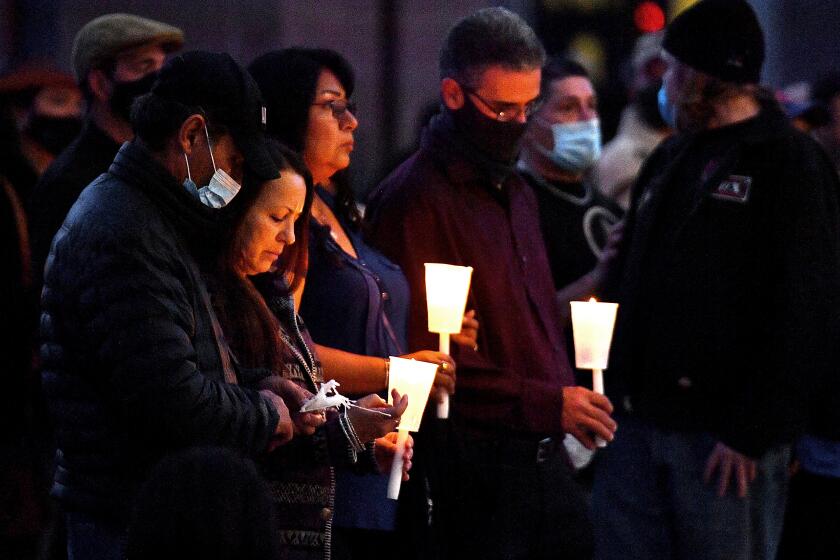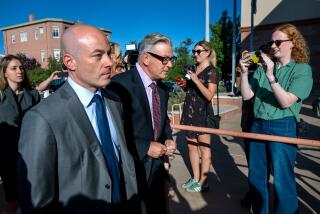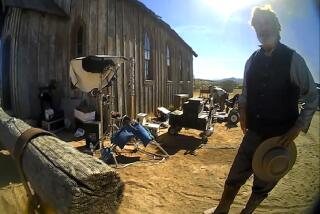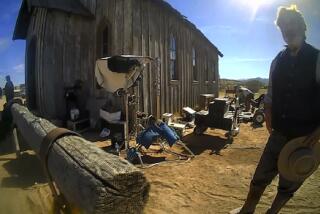How Hutchins’ death has become another rallying cry for film set safety
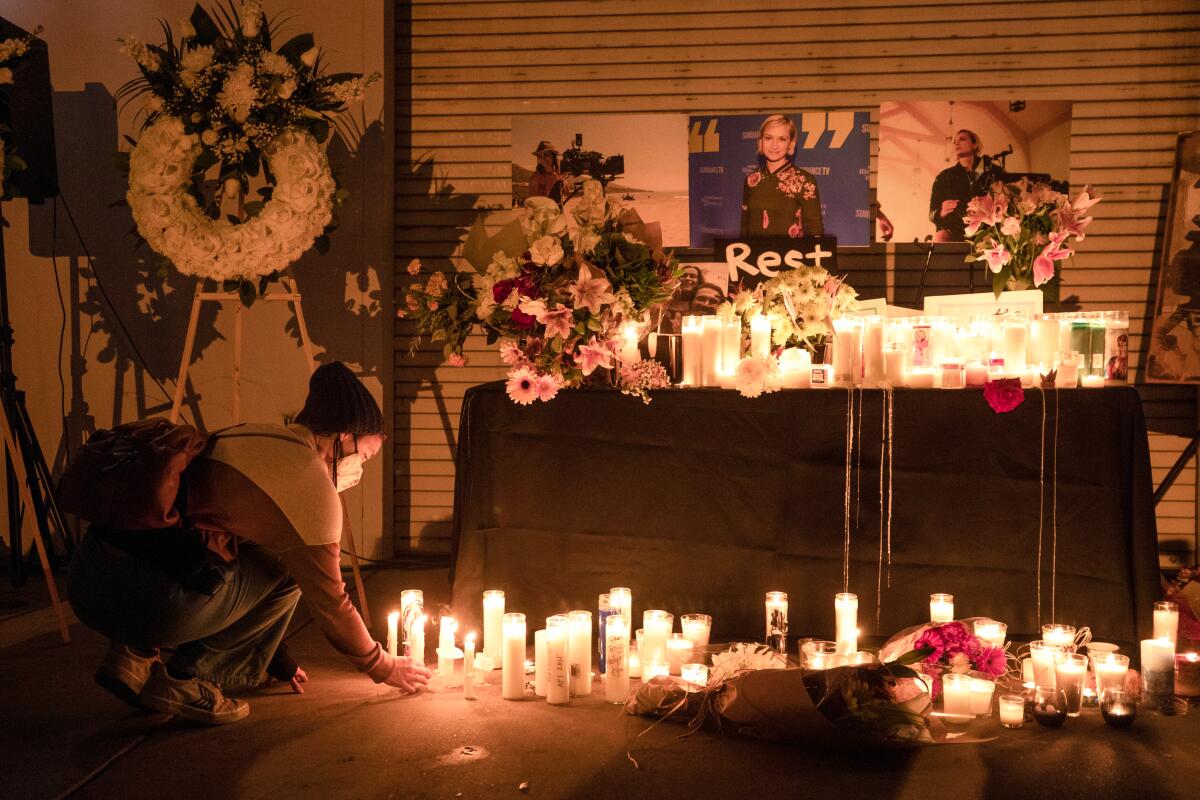
- Share via
Standing before a somber crowd of some 300 film workers Sunday night, a display of floral wreaths and photos of cinematographer Halyna Hutchins behind him, IATSE Vice President Michael Miller spoke to the mix of raw emotions many were feeling.
They gathered in a parking lot off Olive Street in Burbank to pay tribute to Hutchins, who was killed Thursday in an accident on the set of the Alec Baldwin western “Rust” in New Mexico — and to vent their outrage.
“We’re here to mourn,” said Miller, who is also director of motion picture and television production. “But I’m afraid we are also gathered with some frustration and a little bit of anger. Anger that too often the rush to complete productions and the cutting of corners puts safety on the back burner and puts crew members at risk.”
Handing out black ribbons before the candlelight vigil began, set medic Margarita Velona held back tears as she spoke of the carelessness that had led to Hutchins’ needless death.
“I want to see safety,” she said. “This is our livelihood. Halyna was one of ours, and now a child has no mom, a husband doesn’t have a wife, parents don’t have child.”
The vigil, which followed a similar event held Saturday in Albuquerque, carried a disheartening sense of deja vu.
In 2014, hundreds of film workers held a candlelight vigil and march on Sunset Boulevard after the death of camera assistant Sarah Jones, who was struck by a freight train on a trestle in Georgia during the filming of “Midnight Rider.” Several other crew were injured.
At the time, Jones’ death was seen as a galvanizing moment for the film industry, prompting calls for greater attention to safety on film and television productions. Now, seven years later, Jones’ father, Richard, is heartbroken to see another life cut short by a senseless accident on a movie set.
Legal experts weigh in on whether crew and producers of “Rust” could face civil or criminal liability in the death of cinematographer Halyna Hutchins.
“In a way, this kind of relives losing my daughter, and certainly my heart goes out to the family,” said Jones, who has continued to push for greater awareness and accountability for safety on sets through the Sarah Jones Film Foundation. “It’s just a carelessness that is taking place. If these people in charge just respect the human beings ... that they’re in charge of, I don’t see how they can be so reckless.”
Anguish in Hollywood over Hutchins’ death — exacerbated by reports of unrest on the set of “Rust” over working conditions and safety issues — comes at a moment when film crews are already on edge. This month, concerns over working conditions and long hours nearly sparked a walkout by the union representing film and television crews, the International Alliance of Theatrical Stage Employees.
At the eleventh hour, the union negotiated a new contract on behalf of 40,000 members in 13 Hollywood locals, averting the first nationwide strike in its 128-year history.
But reaction to the deal has been mixed, with some union members arguing it didn’t go far enough to improve often grueling working conditions and rein in long hours. Those concerns have only grown more urgent in the last year, as producers pushed crews to make up for lost time caused by pandemic-driven shutdowns.

Some union members believe the Hutchins tragedy could influence the outcome of the ratification vote, tilting some who were on the fence to vote against the deal.
“It’s a tidal wave shift,” said Los Angeles costumer and IATSE member Wendy Greiner. “My friends and I are all going to vote no…. People have had it.”
Union leaders, however, are confident the agreement will be approved by a majority of members.
When it comes to the handling of firearms on sets, the industry has long maintained detailed and comprehensive rules, devised by unions and employers and available for all cast and crew members to see.
On the set of “Rust,” however, standard safety protocols, including gun inspections and safety meetings, were not strictly followed, and concerns had been raised about two accidental prop gun discharges, sources told the Los Angeles Times.
Hours before actor Baldwin fatally shot Hutchins with a prop revolver gun, half a dozen camera crew workers walked off the set to protest working conditions, The Times reported.
Industry guidelines state that guns should not be pointed at people, no real bullets should be near sets and only the prop master or armorer should hand out weaponry.
No criminal charges have been filed in the case, which is being investigated by authorities in Santa Fe, N.M.
Baldwin was given the gun by assistant director Dave Halls, who indicated it was safe to use in the moments before the actor fired it, court records show. The assistant director did not know the prop gun was loaded with any live rounds, according to a search warrant filed in a Santa Fe County court. Halls did not respond to The Times’ request for comment.
Director Joel Souza, who was also injured in the accident on Thursday, told authorities that the day started late because they were trying to hire another crew after the camera workers walked off the set. The workers had sent a letter to producers complaining about long hours and compensation, according to court records.
The affidavit also indicates that Souza and another crew member weren’t sure if the gun had been checked before it was handed to Baldwin.
The production company, Rust Movie Productions, said Friday in a statement that it was “not made aware of any official complaints concerning weapon or prop safety on set,” and that it would be conducting an internal review and was cooperating with authorities.
Since Thursday’s incident, attention has been drawn to the relative inexperience of the film’s 24-year-old armorer, Hannah Gutierrez Reed, who had served as lead armorer on only one film before “Rust.”
Armorer Mike Tristano, who has amassed hundreds of screen credits, including “Saw” and “The Purge,” over a 35-year career, said he’s seen a worrisome decline in professionalism on sets as budgets have been squeezed and crews have been placed under increasing pressures.
“This used to be a business of just professional people,” Tristano said, noting that no licensing is required to serve as an armorer in New Mexico. “Now it’s a business of amateurs because nobody wants to pay for professional people. I guarantee you if me and my team were on that movie, [Hutchins] would be alive today. Because we run such a tight ship and our safety protocols are so that this cannot happen ever. “
At least one of the camera operators complained last weekend to production managers about gun safety on the set.
Tristano worked with Baldwin once before, on the 1999 film “Thick as Thieves,” and said he “never had an issue with him” when it came to gun safety on that set.
After Hutchins’ death, many have asked whether still-tighter safety protocols are required.
“My initial reaction was no possible way this happens on a movie set unless the existing protocols related to how you handle firearms are being ignored,” said lawyer Jeff Harris of Harris Lowry Manton, who represented the families of Jones and of stuntman John Bernecker, who died on the set of AMC’s “The Walking Dead” in 2017, in wrongful-death lawsuits.
“The more I look into this case, the more I’m thinking maybe we do need to beef up some of these areas to make sure this never happens again,” he said.
Others argue enhanced safety measures will not be enough to prevent accidents as long as crews continue to be forced to work under exhausting, pressure-cooker conditions.
“Even if you do put protocols in place, you still have the possibility for awful things like this to happen,” said Bill Dill, a cinematographer and professor at Chapman University, who had Hutchins as a student several years ago at the American Film Institute Conservatory.
“Movie sets are dangerous places. They’re also places where people make a lot of money,” Dill said. “When you get that bad combination, there are conditions allowed on a movie set that wouldn’t be allowed in a factory.”
Hutchins’ death has many in the filmmaking community asking why firearms capable of causing injury or death are still being used on sets at all, given the ready availability of safer alternatives.
Hundreds gathered to mourn the cinematographer Saturday night in Albuquerque.
In recent days, film and TV productions have begun to reconsider the use of real weapons, and a California state lawmaker called for an outright ban of firearms on sets. ABC’s popular procedural “The Rookie,” for example, has banned the firing of real guns on the show in response to Thursday’s fatal shooting.
On Sunday, actress and director Olivia Wilde voiced support for that idea, writing on Twitter, “Hollywood: It’s time to create ‘Halyna’s Law,’ which will ban the use of real firearms on film production sets and create a safe working environment for everyone involved.”
Indie filmmaker Graham Skipper, who has directed and produced a number of low-budget genre films involving weaponry, including 2017’s “Sequence Break,” said convincing on-screen gunplay effects can be easily created in post-production at a lower cost than firing blanks and with none of the attendant risk of physical harm.
“I don’t see any reason for us to have real firing weapons on set,” Skipper said. “One person at a computer with the most basic editing software can make muzzle flashes. We’re not talking about the dinosaurs in ‘Jurassic Park’ here.”
The conversation among Hollywood production workers centers on Dave Halls and the role of the first assistant director on the set of ‘Rust.’
Producer Kim Sherman, who worked with Hutchins last year on the indie sci-fi superhero film “Archenemy,” said the issues raised by her death go far deeper than gun safety to the sometimes dehumanizing economic imperatives of the film business.
“The people who are actually making the thing are putting their bodies on the line, and the people who have the money don’t care that those bodies are piling up,” Sherman said. “It’s systemic. And right now IATSE has the opportunity to do something major that won’t just affect our industry but will affect so many industries facing similar issues.”
Times staff writers Meg James and Mark Olsen contributed to this report.
More to Read
Inside the business of entertainment
The Wide Shot brings you news, analysis and insights on everything from streaming wars to production — and what it all means for the future.
You may occasionally receive promotional content from the Los Angeles Times.

